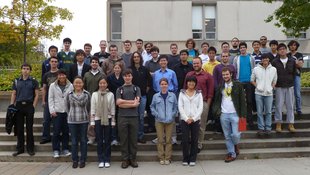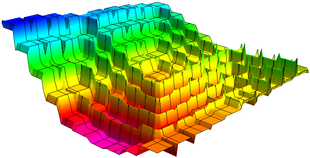10-327/Homework Assignment 3
| ||||||||||||||||||||||||||||||||||||||||||||||||||||||||||||
Reading
Read sections 19, 20, 21, and 23 in Munkres' textbook (Topology, 2nd edition). Remember that reading math isn't like reading a novel! If you read a novel and miss a few details most likely you'll still understand the novel. But if you miss a few details in a math text, often you'll miss everything that follows. So reading math takes reading and rereading and rerereading and a lot of thought about what you've read. Also, preread sections 24 and 26, just to get a feel for the future.
Doing
Solve the following problems from Munkres' book, though submit only the underlined ones: Problems 6, 7 on page 118, and problems 3, 4, 5, 6, 8, 9, 10 on pages 126-128.
Class Photo
Identify yourself in the 10-327/Class Photo page!
Due date
This assignment is due at the end of class on Monday, October 18, 2010.
Suggestions for Good Deeds
Annotate our Monday videos (starting with Video: ![]() Topology-100927) in a manner similar to (say)
Topology-100927) in a manner similar to (say) ![]() AKT-090910-1, and/or add links to the blackboard shots, in a manner similar to
AKT-090910-1, and/or add links to the blackboard shots, in a manner similar to ![]() Alekseev-1006-1. Also, make constructive suggestions to me, Dror and / or the videographer, Qian (Sindy) Li, on how to improve the videos and / or the software used to display them. Note that "constructive" means also, "something that can be implemented relatively easily in the real world, given limited resources".
Alekseev-1006-1. Also, make constructive suggestions to me, Dror and / or the videographer, Qian (Sindy) Li, on how to improve the videos and / or the software used to display them. Note that "constructive" means also, "something that can be implemented relatively easily in the real world, given limited resources".
| Dror's notes above / Student's notes below |
Discussion
- Question about HW3 8(b). I still don't understand why the uniform topology on is strictly finer than the product topology. If you find any open nbd in uniform topology of any point in only finitely many component are in the form of because the sequence has infinitely many 's. Can't I just choose these multiply by infinitely many copies of in the product topology? -Kai
- Good thought, but there is something wrong in your logic. This though remains your assignment to do, so what I'll write may sound a bit cryptic: Note that in the uniform topology, the constraint applies also to the 's. Drorbn 18:13, 12 October 2010 (EDT)
- But once you get the intersection with , those constraints should disappear?
- No. Drorbn 21:18, 12 October 2010 (EDT)
- But once you get the intersection with , those constraints should disappear?
- Good thought, but there is something wrong in your logic. This though remains your assignment to do, so what I'll write may sound a bit cryptic: Note that in the uniform topology, the constraint applies also to the 's. Drorbn 18:13, 12 October 2010 (EDT)
- Hi Dror, 8(b)(c) are really difficult and they involve several different concepts about infinity. Do you think you can go through them in class? Different concepts of infinity seem to be really intricate and I don't know how to argue properly. It seems it is true either way evenly philosophical in my point of view. Although its my homework assignment to do I still want to learn how to argue in questions like that. I hope you can teach us for learning purposes rather than marks. Maybe some other smart guys probably have already figured that out but I am not as smart. But this doesn't change the fact that I want to learn. Thanks. -Kai Xwbdsb 23:56, 12 October 2010 (EDT)
- Part of the reason I've decided to extend the deadline for this assignment is to have more time to talk about it in class. Drorbn 06:53, 14 October 2010 (EDT)
- I really have been spending a whole day on this assignment but still nothing comes to my mind how to prove box topology is strictly finer than topology. Dror could you possibly explain on this for a little bit please? -Kai Xwbdsb 00:18, 13 October 2010 (EDT)
- That may be a good topic for a few minutes in class. If the question will be raised I'll try to give a hint. Drorbn 06:53, 14 October 2010 (EDT)
- For a sequence to eventually end with 0's, does it mean that it can only have finitely many non zeros terms? How about for a sequence with infinitely many 0's does it mean that the sequence can only have finitely many non-0 terms? -Kai
- I think the answer to your first question is yes: Quote Munkres page 118 q7 " ... all sequences that are eventually zero, that is all sequences (x1, x2, ...) such that xi != 0 for finitely many values of i". The answer to the second question, I think is no: consider (1, 0, 1, 0, 1, 0 ...). Please correct me if I'm wrong. By the way, i've also been working on this homework for the past two days, and still did not finish... so I'm a dumb-dumb too :):) - Oliviu
- I completely agree with you. its not that you are dumb but it is really hard especially the last one. Who by any chance know how open balls of l2 topology looks like in either R^infinity or Hilbert cube? I have no idea and cannot conceptualize what is going on. Xwbdsb 01:35, 14 October 2010 (EDT)
- I think the answer to your first question is yes: Quote Munkres page 118 q7 " ... all sequences that are eventually zero, that is all sequences (x1, x2, ...) such that xi != 0 for finitely many values of i". The answer to the second question, I think is no: consider (1, 0, 1, 0, 1, 0 ...). Please correct me if I'm wrong. By the way, i've also been working on this homework for the past two days, and still did not finish... so I'm a dumb-dumb too :):) - Oliviu
- I would like to share a hint from Dror with everybody who cares. This thing puzzled me so that I couldn't figure a lot of things out. We can think of R^infinity as a space with all the sequences eventually end with 0. You might think that a sequence can only have finitely many non-zero terms. You are right. But philosophically does finite really mean "finite"? The hint here is that you can have a sequence that has as many non zero terms as you want in R infinity as long as it is finite... !!really as many non-zero terms as you want!! That just means that they sort of behave similarly to those sequences that have infinitely many non-zero terms. But the subtlety is there we cannot misunderstand it. -KaiXwbdsb 00:40, 15 October 2010 (EDT)
- Anybody wants to share the happiness of solving HW3? This HW is so tough.. It really took me 11 pages to solve 8 which I never thought I could... We should definitely help each other out here on Wiki because the assignments are getting harder and harder. I would like to be the first person to help here on Wiki... -Kai Xwbdsb 00:40, 16 October 2010 (EDT)

![{\displaystyle [0,1]}](https://wikimedia.org/api/rest_v1/media/math/render/svg/738f7d23bb2d9642bab520020873cccbef49768d)








